Read our Kajabi vs ClickFunnels comparison. Explore their features, such as digital product hosting, marketing tools, and more, to make an informed decision.
Key takeaways
- Kajabi excels at digital products like courses, podcasts, and newsletters with superior content creation features.
- ClickFunnels offers more native integrations than Kajabi, including key platforms like Slack and Klaviyo.
- Kajabi provides better marketing automation with advanced email sequences and copy templates compared to ClickFunnels.
- ClickFunnels dominates in sales funnel creation with 10+ pre-built funnel templates and detailed conversion tracking.
- Both platforms tie overall with each winning in different core business areas and functionalities.
Creators, podcasters, course makers, coaches–you all want one thing for your business: an all-in-one platform to host your activities. Two of the biggest names in the space are Kajabi and ClickFunnels, so it’s only fitting that I pit them against each other.
Both platforms are great, but which one stands out? That’s what I want to find out in this article. I signed up on Kajabi and ClickFunnels and played around with their features, trying to find which one has an edge over the other and where each falls short.
Let me not waste your time; let's get straight into Kajabi vs ClickFunnels.
Kajabi vs ClickFunnels: A quick overview
I’ll go a lot more in-depth on both platforms below, but first, let’s go through a quick overview of them.
From what I understood when using these, Kajabi is the winner when it comes to digital products and marketing. From courses to podcasts to newsletters, you can sell them all through dedicated sections within the platform. Plus, their marketing features are superb, and they have a slight edge over ClickFunnels in that aspect (more details below).
ClickFunnels, on the other hand, is the best for selling all other products and converting customers. They’re getting there in terms of digital products, but they still have some way to go to beat Kajabi, in my opinion.
The funnels on CF are second to none. I mean, it’s in the name, after all. On top of this, ClickFunnels has more integrations that will help when it comes to selling physical products.
Here’s a quick rundown of how each platform ranks in terms of a few different features.
| Features | Kajabi | ClickFunnels |
|---|---|---|
| Onboarding | ⭐⭐⭐⭐⭐ | ⭐⭐⭐⭐⭐ |
| Ease of use | ⭐⭐⭐⭐⭐ | ⭐⭐⭐⭐ |
| Product selection | ⭐⭐⭐⭐⭐ | ⭐⭐⭐ |
| Marketing tools | ⭐⭐⭐⭐⭐ | ⭐⭐⭐⭐ |
| Funnels | ⭐⭐⭐ | ⭐⭐⭐⭐⭐ |
| Integrations | ⭐⭐⭐⭐ | ⭐⭐⭐⭐⭐ |
| Price | ⭐⭐⭐⭐ | ⭐⭐⭐⭐⭐ |
Where Kajabi and ClickFunnels succeed, and where they fall short
Okay, so it’s time to get deep into each platform and see where they are doing killer work and where they’re coming up short.
We’ll talk about both platforms in each section and see why one of them is better than the other in some areas.
Best for digital products: Kajabi
Straight off the bat, Kajabi takes the cake when it comes to digital products. I was able to create a course and a community on both platforms, yes. But, from a barebones perspective, Kajabi also allowed me to host coaching classes, newsletters, and podcasts, so it’s a definite win there.
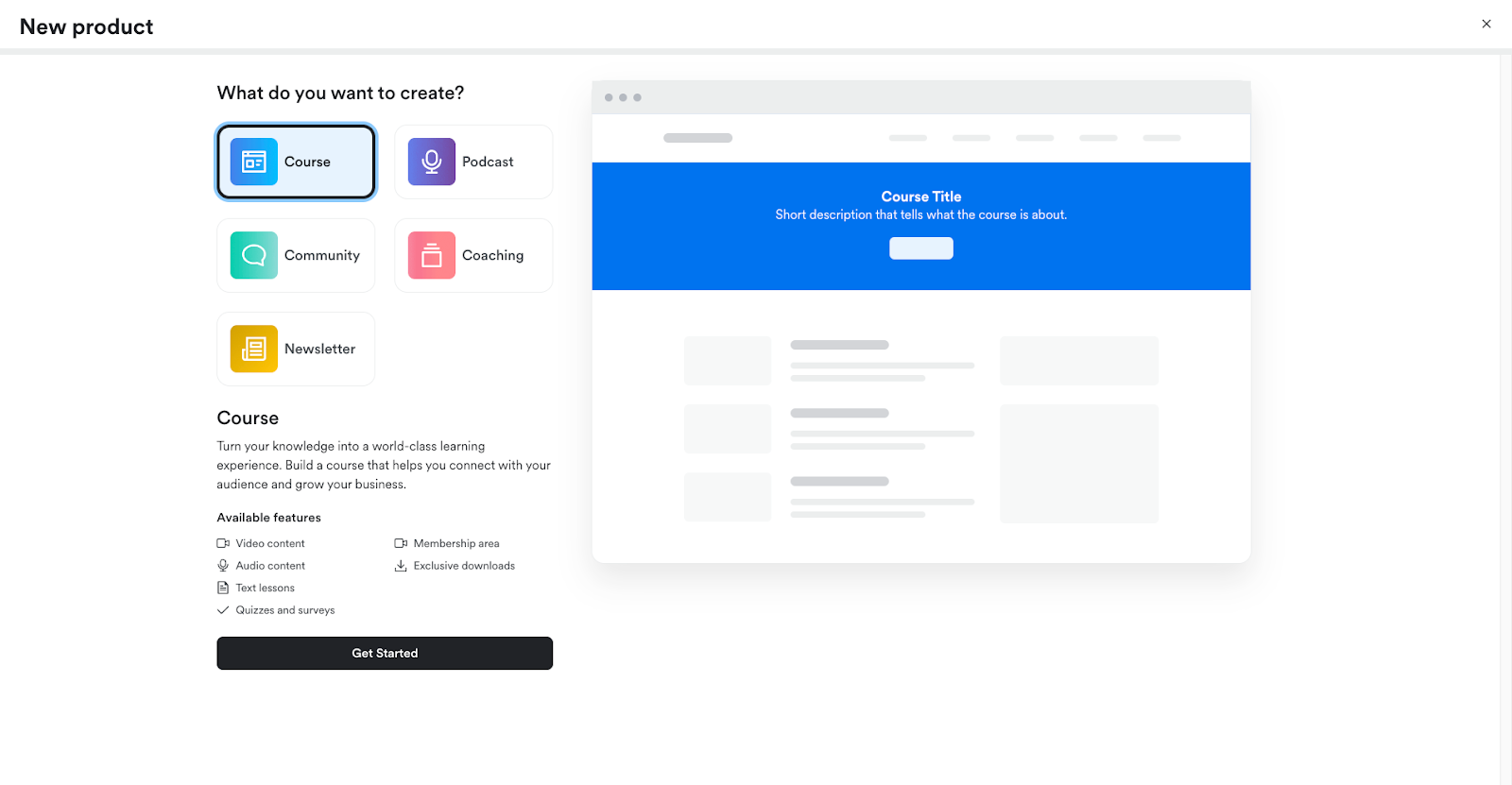
Obviously, Kajabi wouldn’t be so popular if all they had to offer was just a few extra products to sell. They have tons of other features, too, which allow creators to 1. get their money’s worth and 2. get their community engagement to the next level.
For example, let’s look at courses. On Kajabi, I was able to add the course’s name, description, and video and audio files for different lessons. Could I do the same on ClickFunnels? Yes, and at that point, I did like ClickFunnels’ UI a lot more.
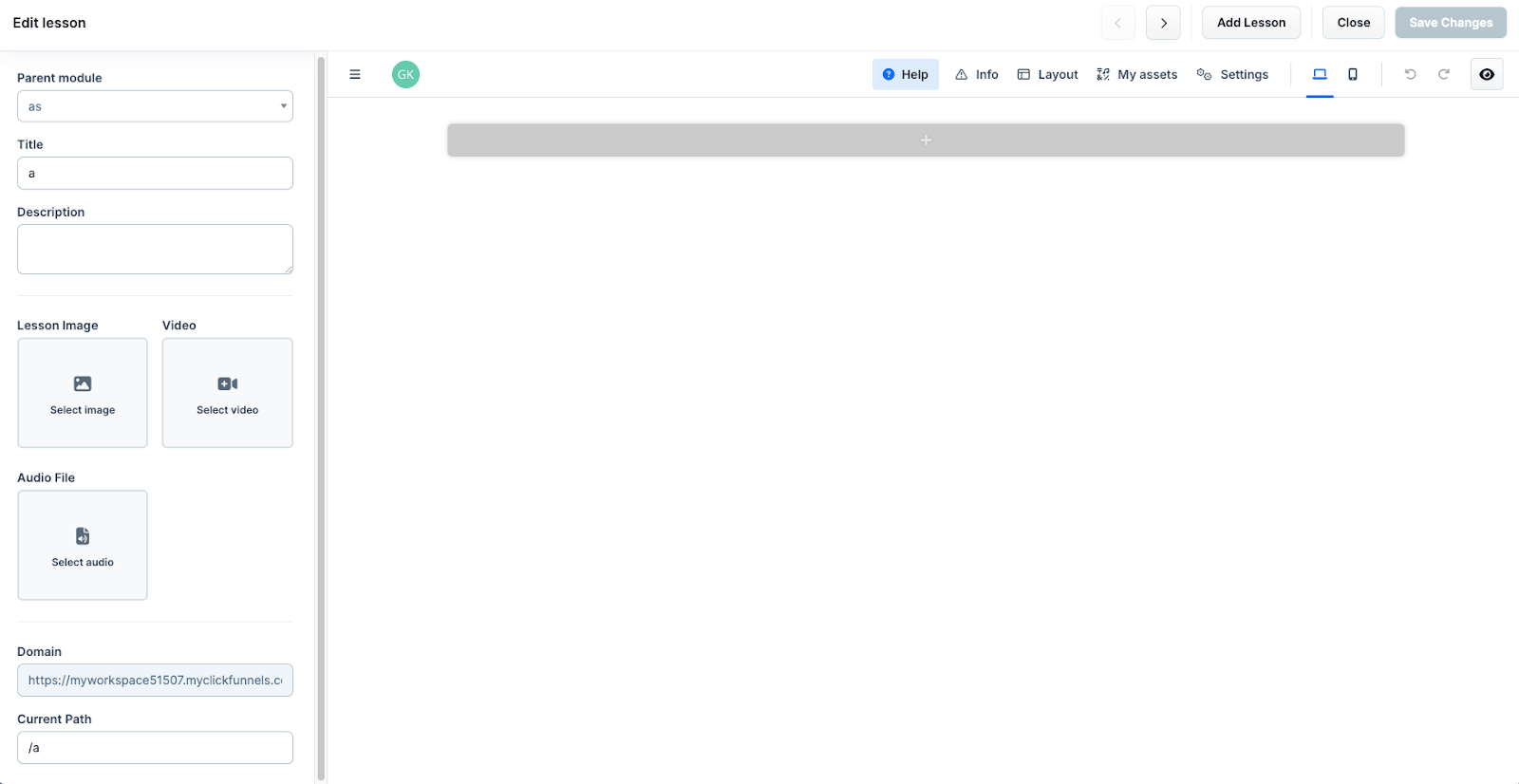
However, here's where Kajabi gained some speed. For one, by just adding a name and a description, the platform’s AI would automatically create an outline for me. But my answer at that point was still ClickFunnels because most creators already have an outline in mind, right?
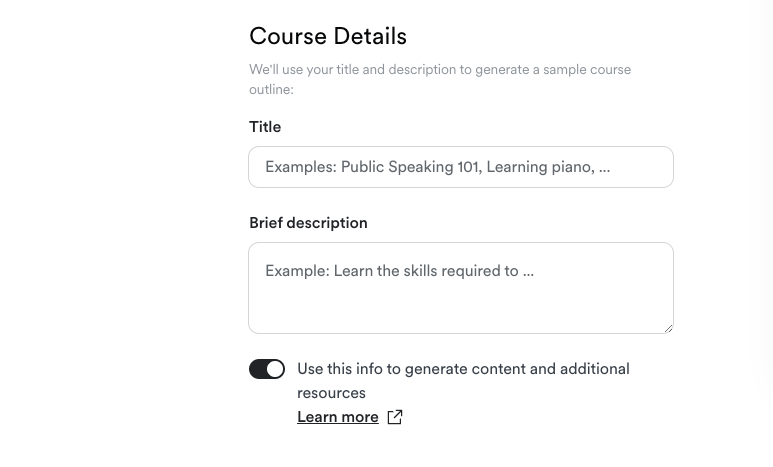
Well, that’s where Kajabi’s expertise in courses came in, and that’s why it’s the winner for me when it comes to courses. Alongside my course, I can also host live Q&As, enable comments, or even create a community for that specific course.
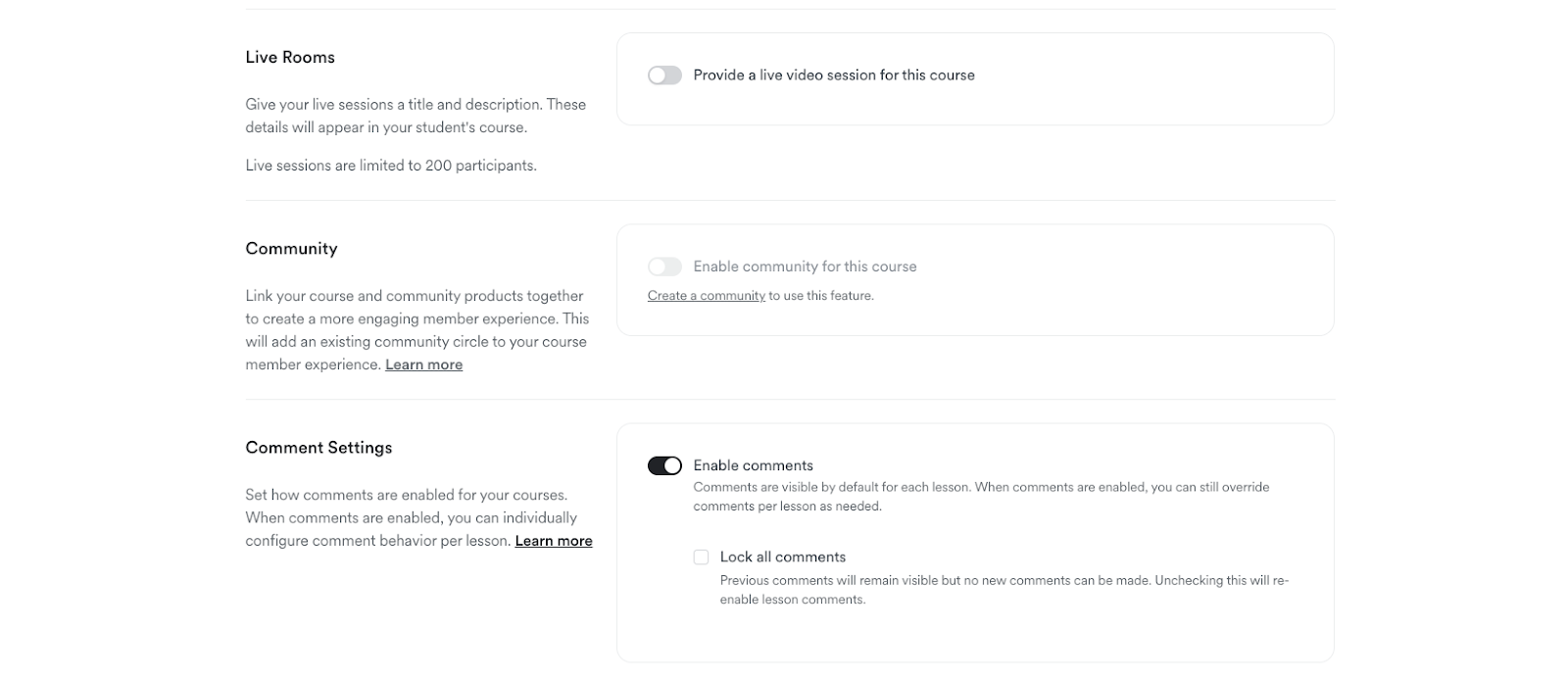
On top of all this, Kajabi has regular lessons and submodules, just like ClickFunnels. But it doesn’t stop there. You’ll also be able to add quizzes in between lessons. These can be multiple-choice or even open-ended questions.
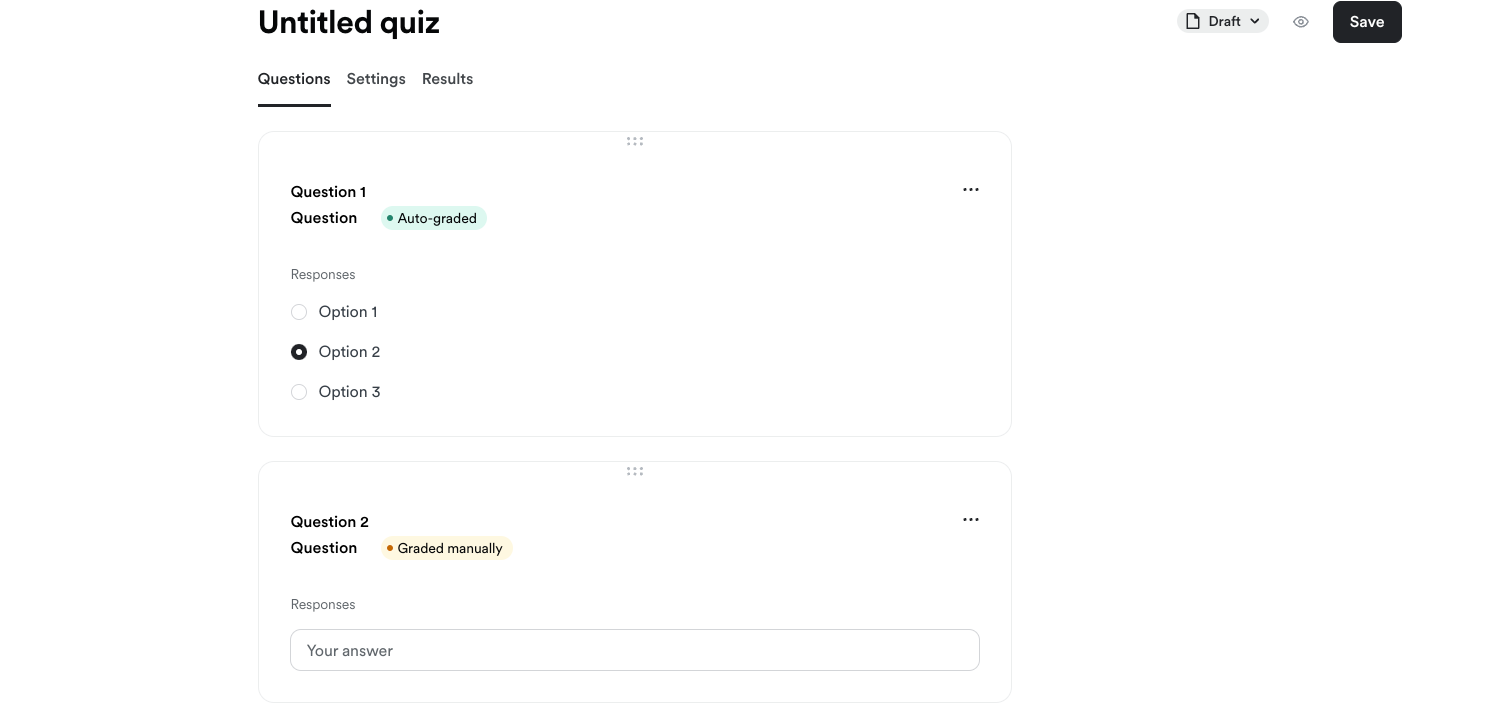
The cherry on top of all of this is Kajabi’s Automations. Instead of manually having to send, say, a Well Done message to a member who completed a lesson or a certificate when they complete the course, you can automate that.
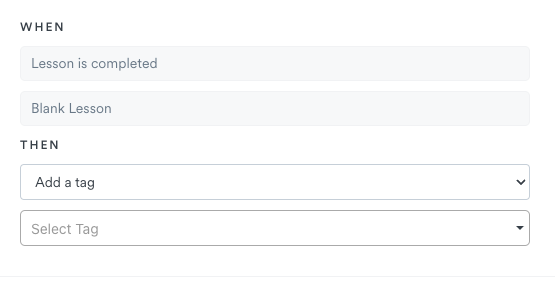
Now, I’ve focused a lot on courses. That’s because the rest are just a landslide win for Kajabi. When it comes to communities, Kajabi allows you to create events and challenges for the community, something you won’t find on ClickFunnels unless you create some sort of funnel for it.
And, as for the rest (coaching, podcasts, and newsletters), ClickFunnels doesn’t have them as options. I have to say that Kajabi has done a great job even with these. I was able to configure my coaching classes to groups instead of 1-on-1s, and creating a newsletter and uploading a podcast took a couple of minutes and a few clicks at a time.
The first point goes to Kajabi. On to the next part that’s essential to any business: marketing.
While you're here, check out our guide on the best alternatives to ClickFunnels.
Best for marketing: Kajabi
This one wasn’t as straightforward. In my opinion, Kajabi takes the win here, but by just a little bit. So, in terms of marketing, I considered what kind of website builders the platforms have, if they have any other marketing tools, what analytics you’re getting, that sort of stuff. Funnels are also technically a part of these tools, but I go over them later below.
We’ll start with ClickFunnels this time around. When it comes to building a website, ClickFunnels came in clutch. I had tons of different templates to choose from, and I could even use a blank canvas and make something from scratch. The only caveat? These are primarily funnel pages, not full-blown websites. But I didn’t take any points from them for this.
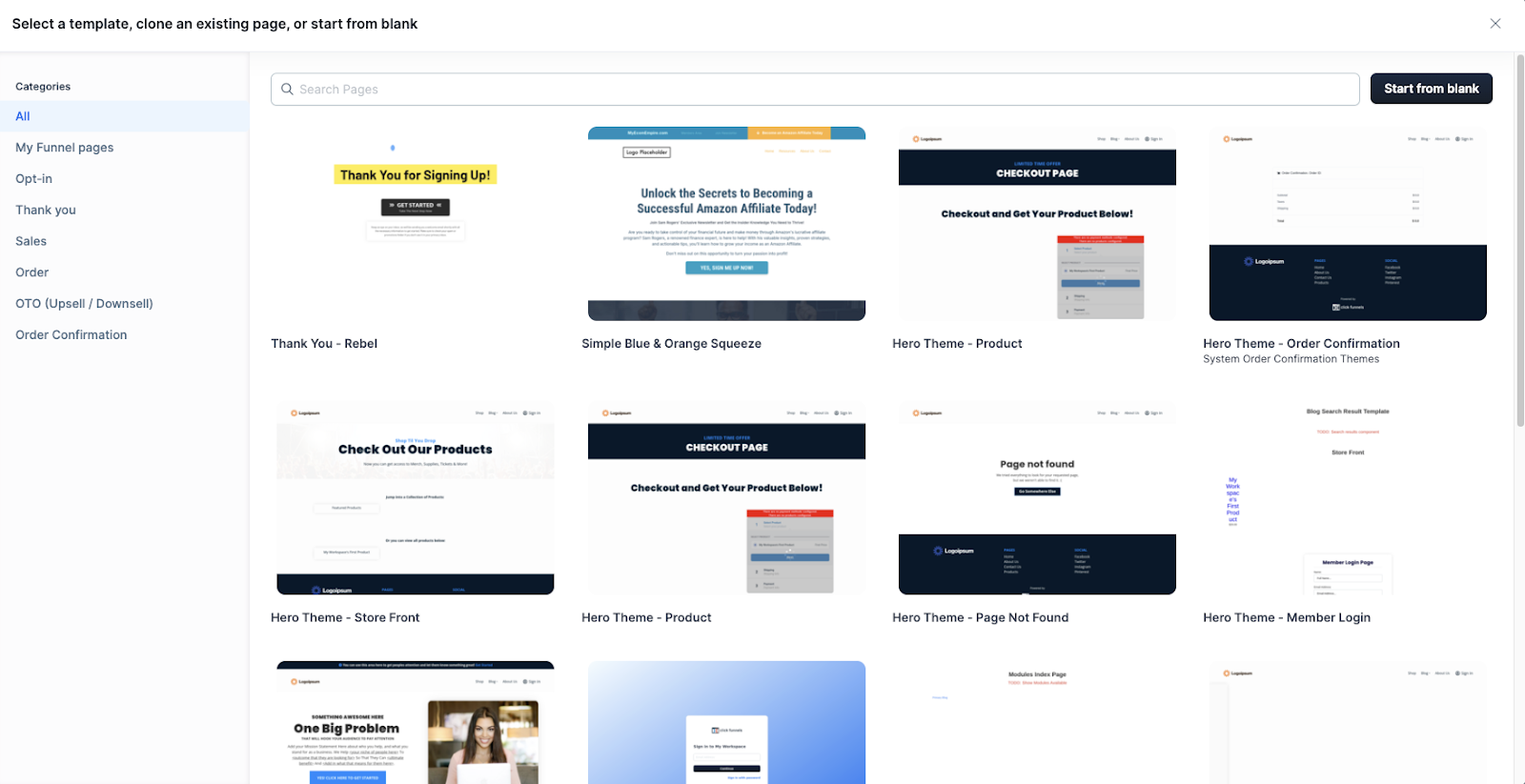
Why didn't I take any points? Because CF has a dedicated app for creating a storefront, which, in my opinion, has one of the best UIs I’ve seen on any platform. It’s simple, it’s straightforward, and it gets the job done.
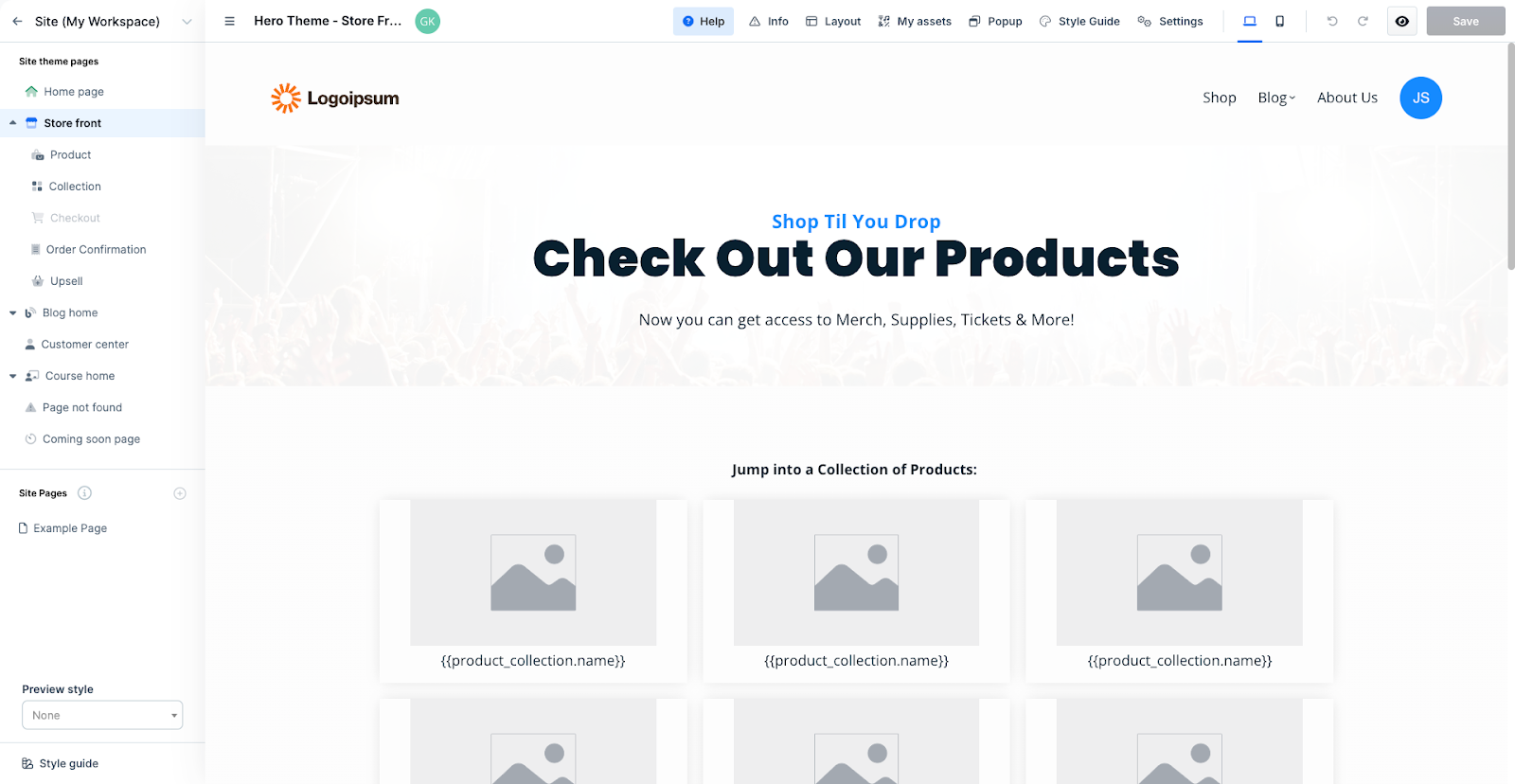
Now, regarding the actual marketing tools, ClickFunnels has started to rank a bit lower. That’s because, besides the analytics page (which you’ll see below) and the barebones email marketing app, there wasn’t anything else that stood out from the native features.
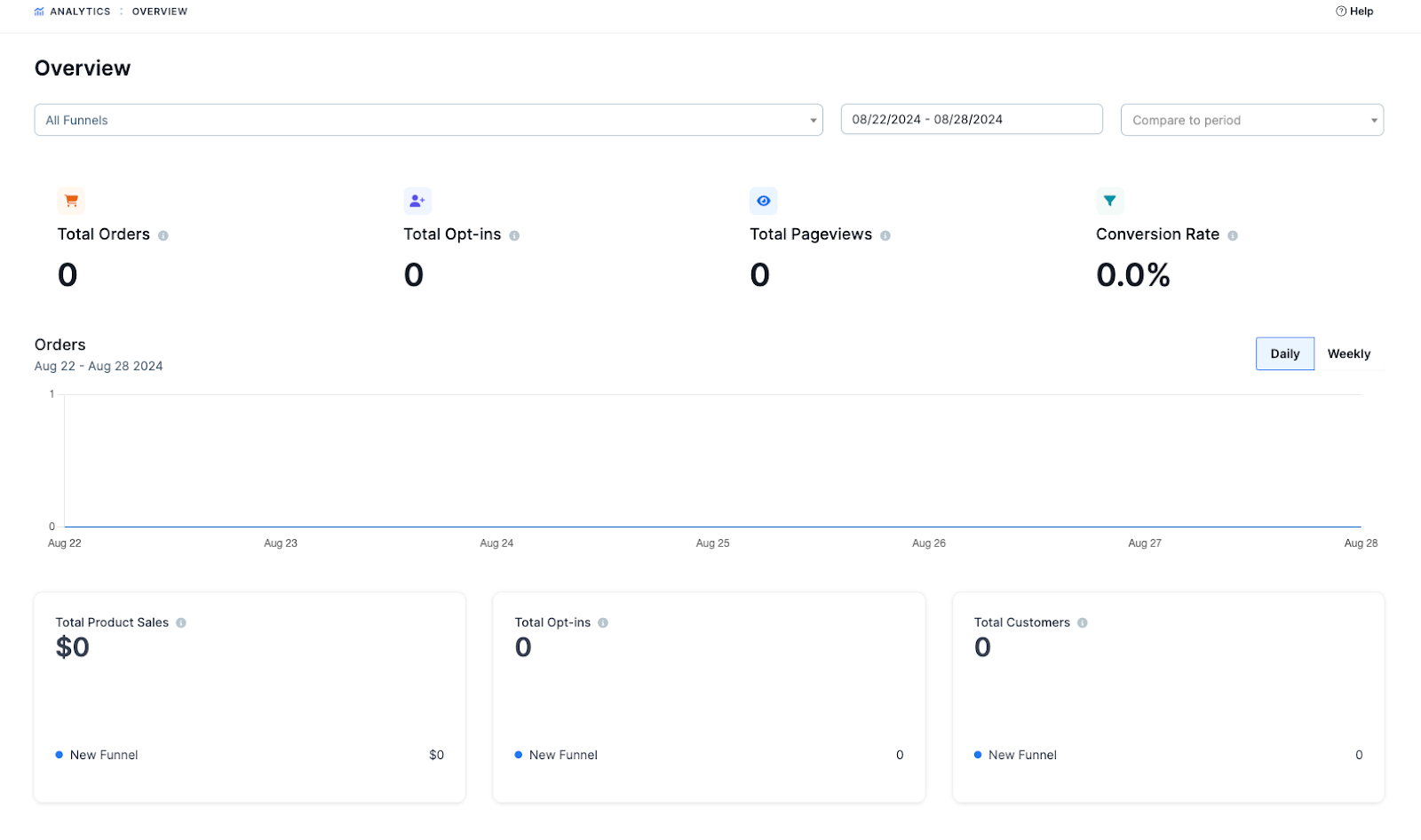
Don’t get me wrong, I loved the simplicity of the analytics, and email marketing is a good starting point for new business. But that’s about it.
And, then, there’s Kajabi. For one, they already get an extra point for having a dedicated tab for all marketing deets. Compared to ClickFunnels, having everything in one place will make it easier for anyone new to these platforms to manage. And even experienced users (or reviewers, in my case) will appreciate this quite a bit.
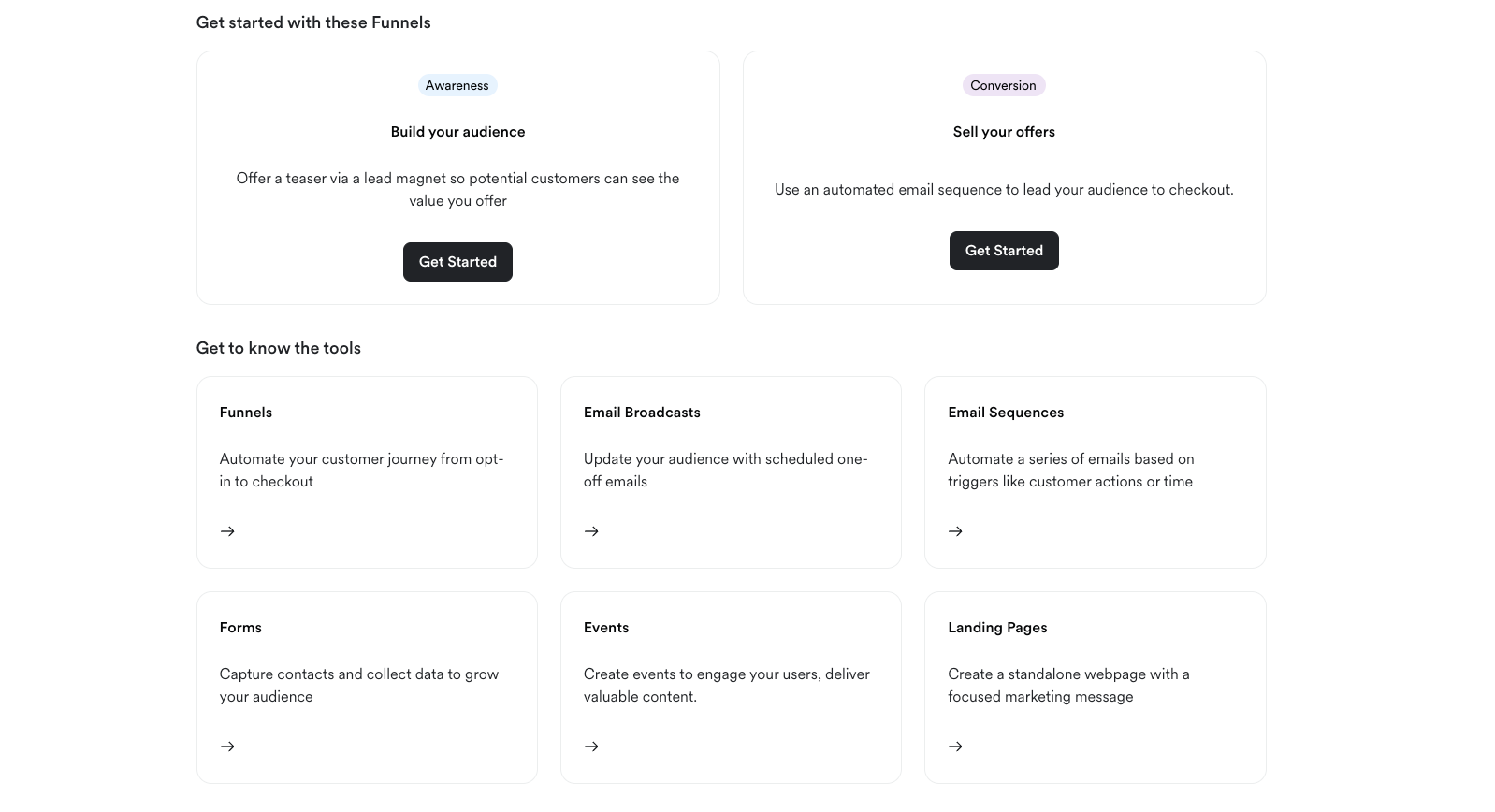
I digress. Let’s go back a step and see the website builder. And that’s an aspect where the two have done an equally great job. I like ClickFunnels UI, but admittedly, Kajabi’s site builder takes the cake just because you can build actual websites through one tab, not have separate funnel pages and storefronts.

As for analytics, I can’t really say which one is the best because they’re both pretty in-depth and have a great UI. The point will go to ClickFunnels, though, since I like their take on the page a little bit more compared to the one Kajabi uses, which you’ll see right below.
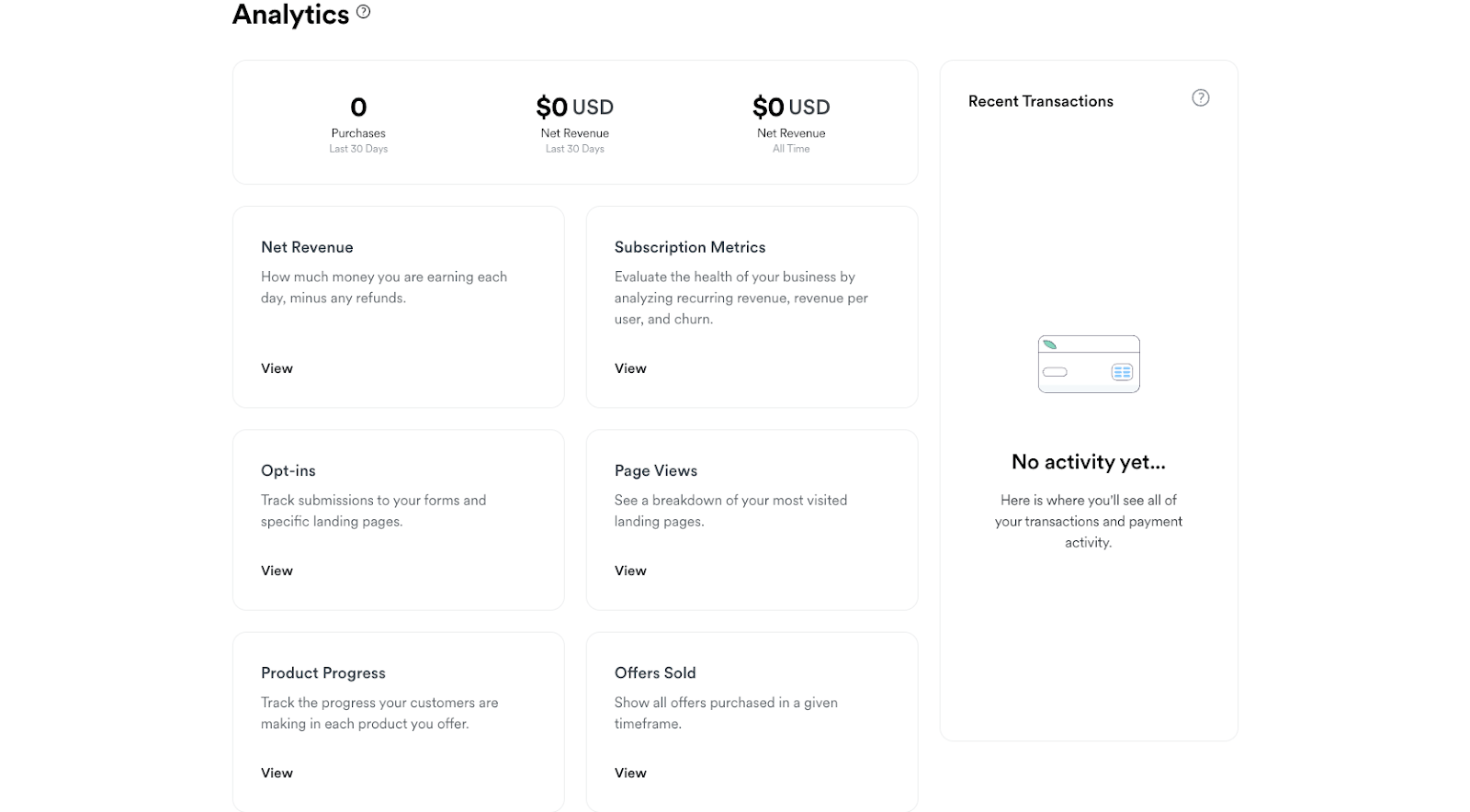
Here’s where Kajabi took the win for this one, though: the actual marketing tools. Starting with their email marketing, Kajabi has pretty much perfected it. I couldn’t use it in full scale because I was on a trial version, but it allows you to create broadcasts, sequences, and events.
ClickFunnels only allows for basic broadcasts, and you’ll have to get a domain if you want to scale the number of these you’ll send out. Kajabi, on top of this, gives you plenty of copy templates that you can edit, so you don’t need a copywriter to help you out. Plus, they also allow for many automations (“when, then, if”, just like their Courses automation).
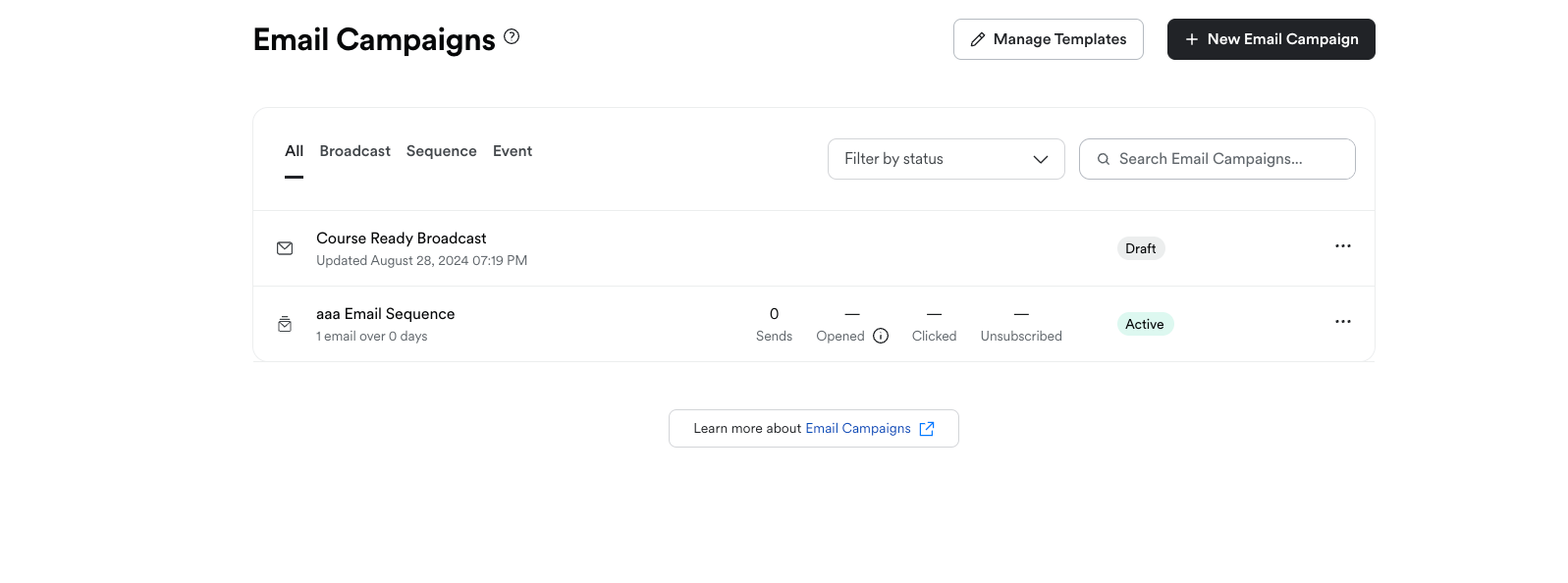
The other marketing tools Kajabi offers include Events and Forms, which are pretty self-explanatory. You can create a quick Event for your community or course members or have them complete forms to be added to waitlists, opt-in for meetups, etc.
Another point to Kajabi.
Best integrations: ClickFunnels
Even all-in-one platforms need integrations, and I’ll admit that both Kajabi and ClickFunnels had plenty of native integrations. You can also connect both of them with Zapier and get access to a few hundred more integrations, as well as integrate them with each other, but that doesn’t affect my ranking.
The point here barely goes to ClickFunnels, primarily because they double the number of native integrations compared to Kajabi. I couldn’t initially decide which platform would get the point here for a couple of reasons.
For one, both platforms made it pretty easy to find the tab with all the integrations. You just go to settings, and it’s right there.
Originally, I’d have given the point to Kajabi for one simple reason. I loved the way you can integrate with most platforms. You se,e when I selected an integration on ClickFunnels, I’d always be redirected to a different tab to input my info.
With Kajabi, the majority of integrations could be done on the same page, and I was just required to paste the API key. Plus, I’d always get a quick link to a guide on how to integrate with that specific platform.
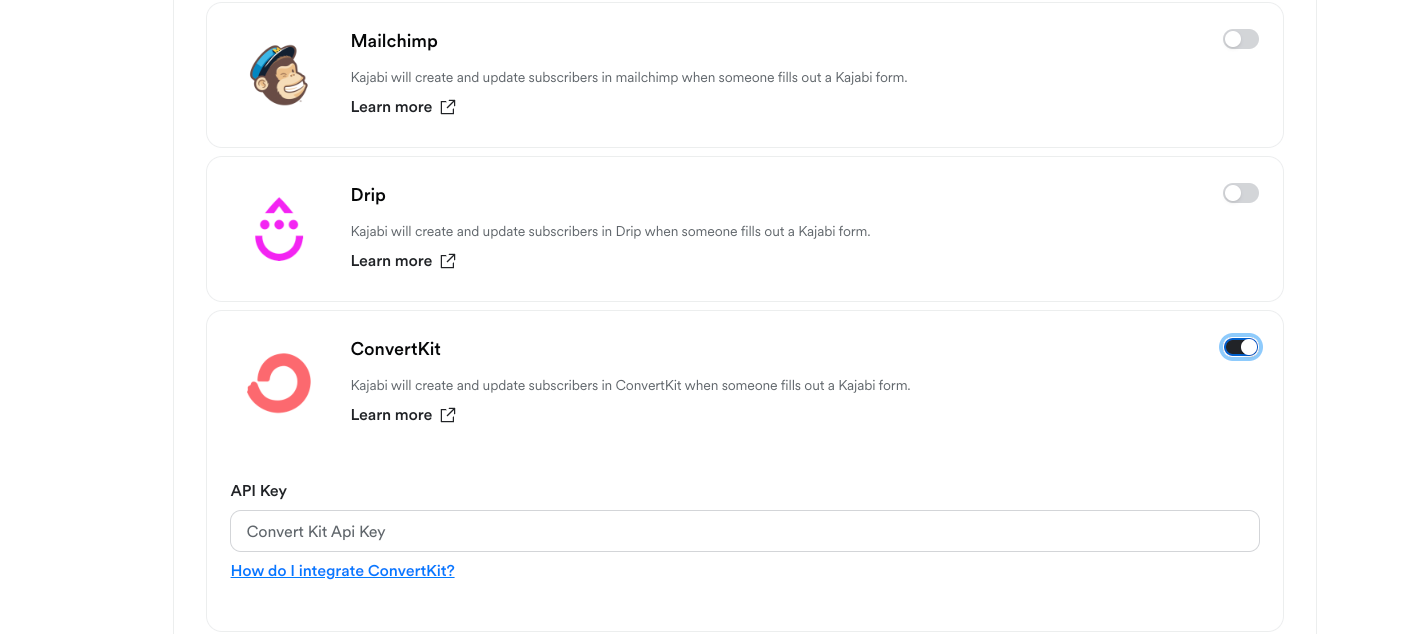
Alas, ClickFunnels does have more integrations, some of which should have also been in Kajabi’s suite, like Slack, Klaviyo, and Beehiiv. And the whole process is still super simple. You just click on the platform, input all the data necessary, and you’re sorted.
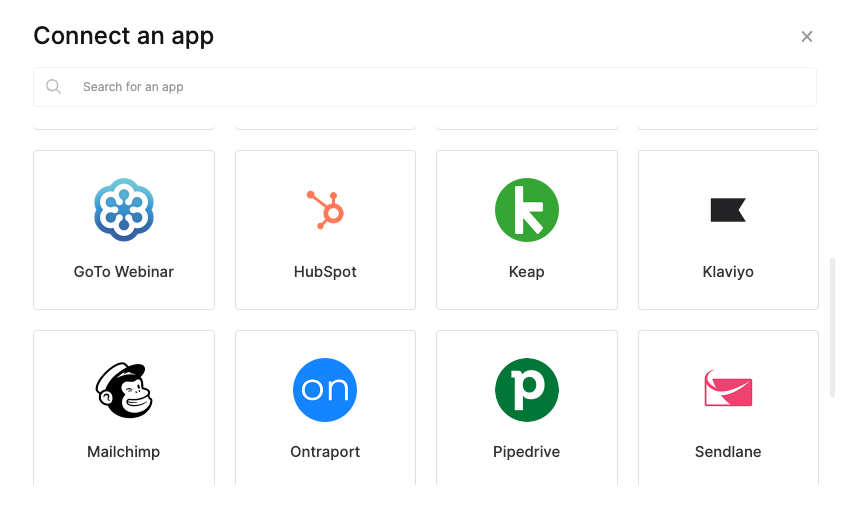
So, the point here goes to ClickFunnels. If Kajabi matches the number of integrations ClickFunnels has, that point would go to them and we’d already have a winner in our comparison.
But we just have one more category left. And fortunately for ClickFunnels, they win this one by a landslide.
Best for converting customers: ClickFunnels
When it comes down to it, you, I, and every other creator or business owner want to convert leads into customers. You want a complete idea of where your potential customers abandon your sales funnel. ClickFunnels will be your best option for this, and it beats Kajabi by quite a bit.
Now, here’s the deal: I specifically left this a separate section to marketing, as it’s more sales-focused. Kajabi does have funnels within their Marketing tab, and, to be fair to them, their funnels are pretty good.
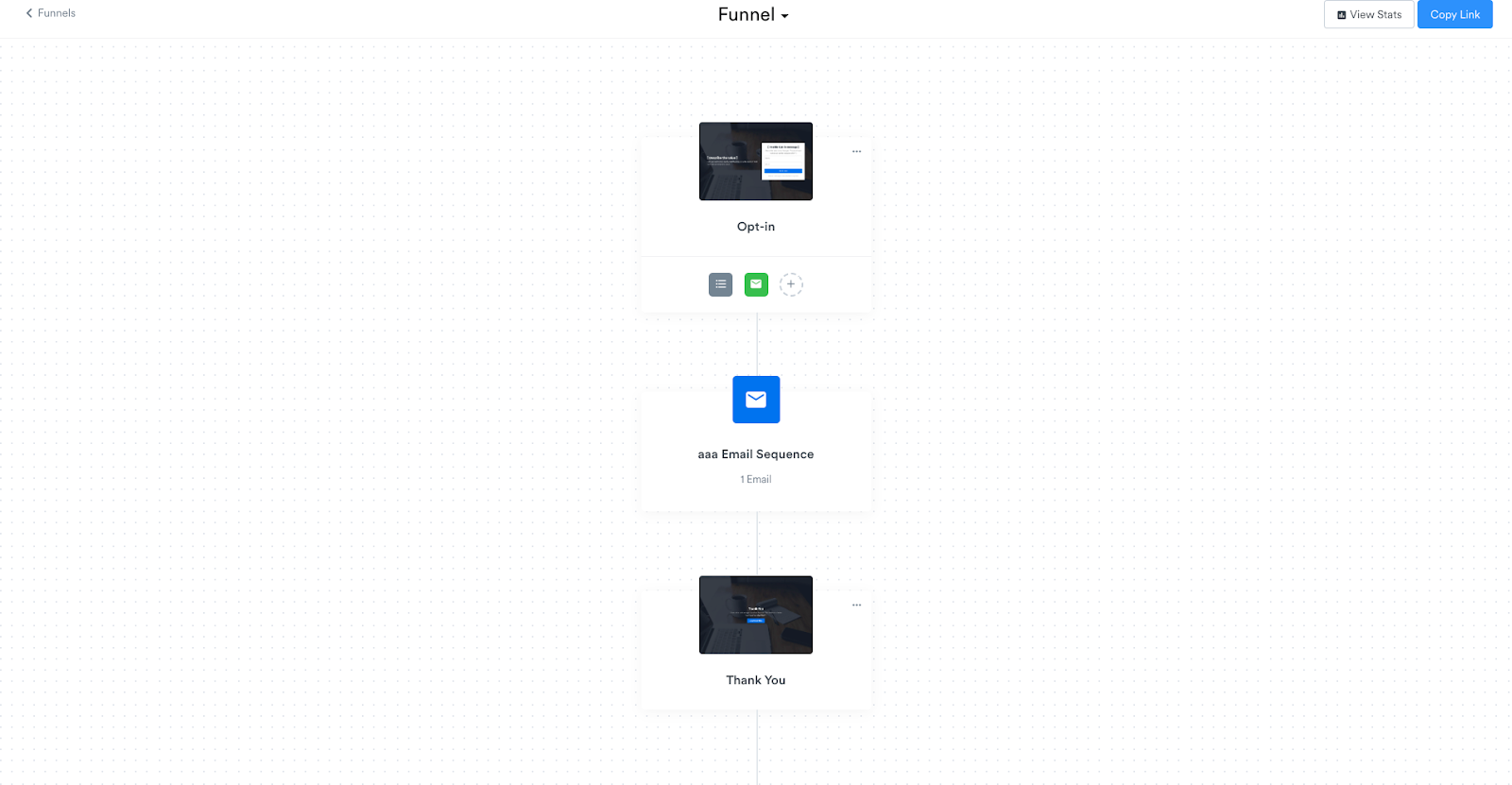
It’s very basic, sure. But it gets the job done. I was able to create a super simple funnel with an opt-in page, followed by a Welcome email sequence and a Thank You page. You can add plenty more pages to these funnels, as well.
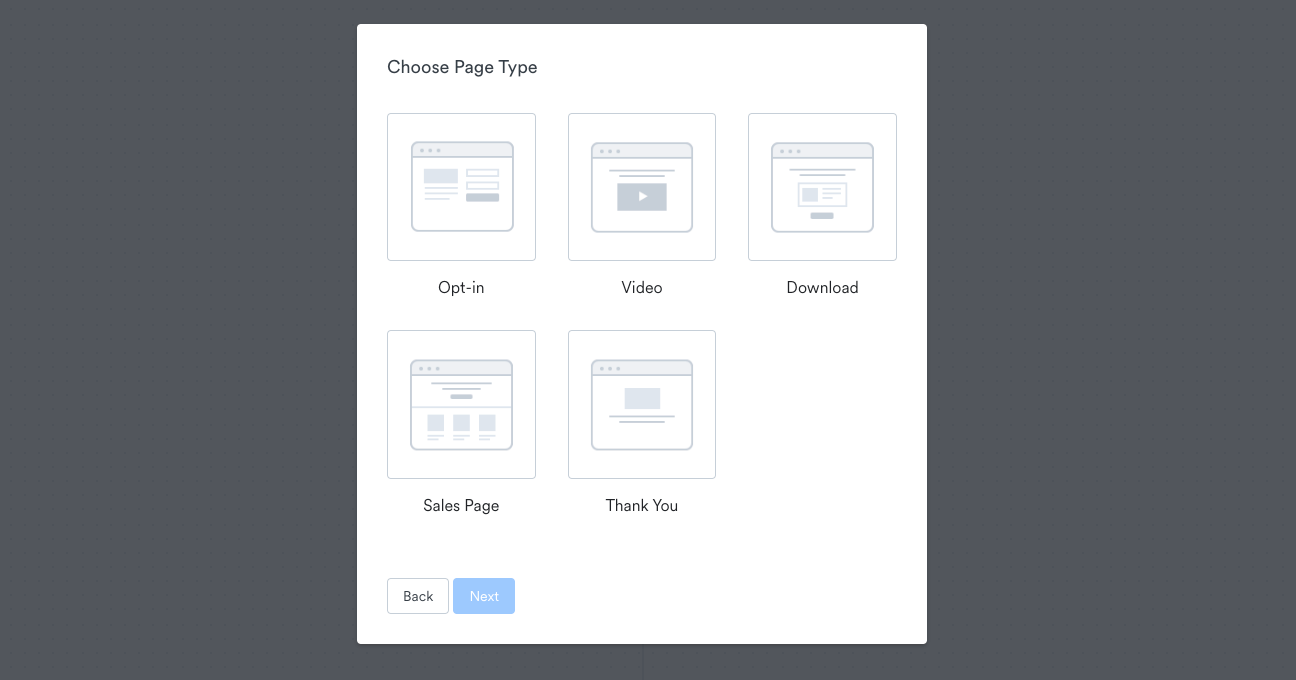
On top of that, you’ll also be able to use the automations I’ve already praised above. All this is great, and at a barebones level, Kajabi’s funnels are more than enough.
But ClickFunnels takes this to a whole different level. I already noticed this from the Funnels tab at the top of my CF dashboard. From the get-go, I got around 10 different funnels to choose from that already had every step mapped out. Or, I could also start from scratch and create my own funnel.
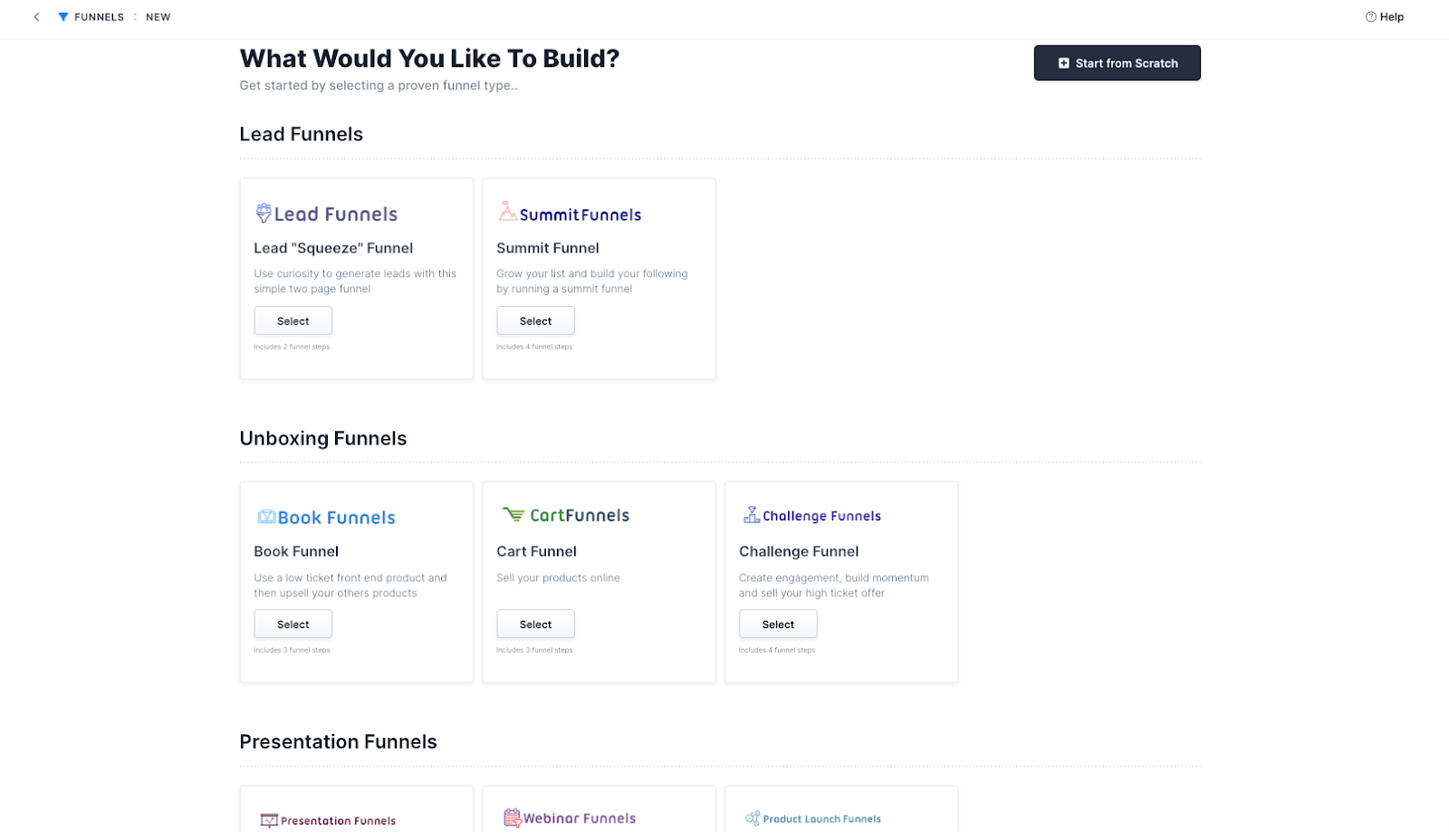
Regardless of which one I selected, I was always forwarded to a page where I could watch a video on how that funnel worked and how I could implement it. I’d also get to choose from many templates and get a clear idea of each step of that funnel.
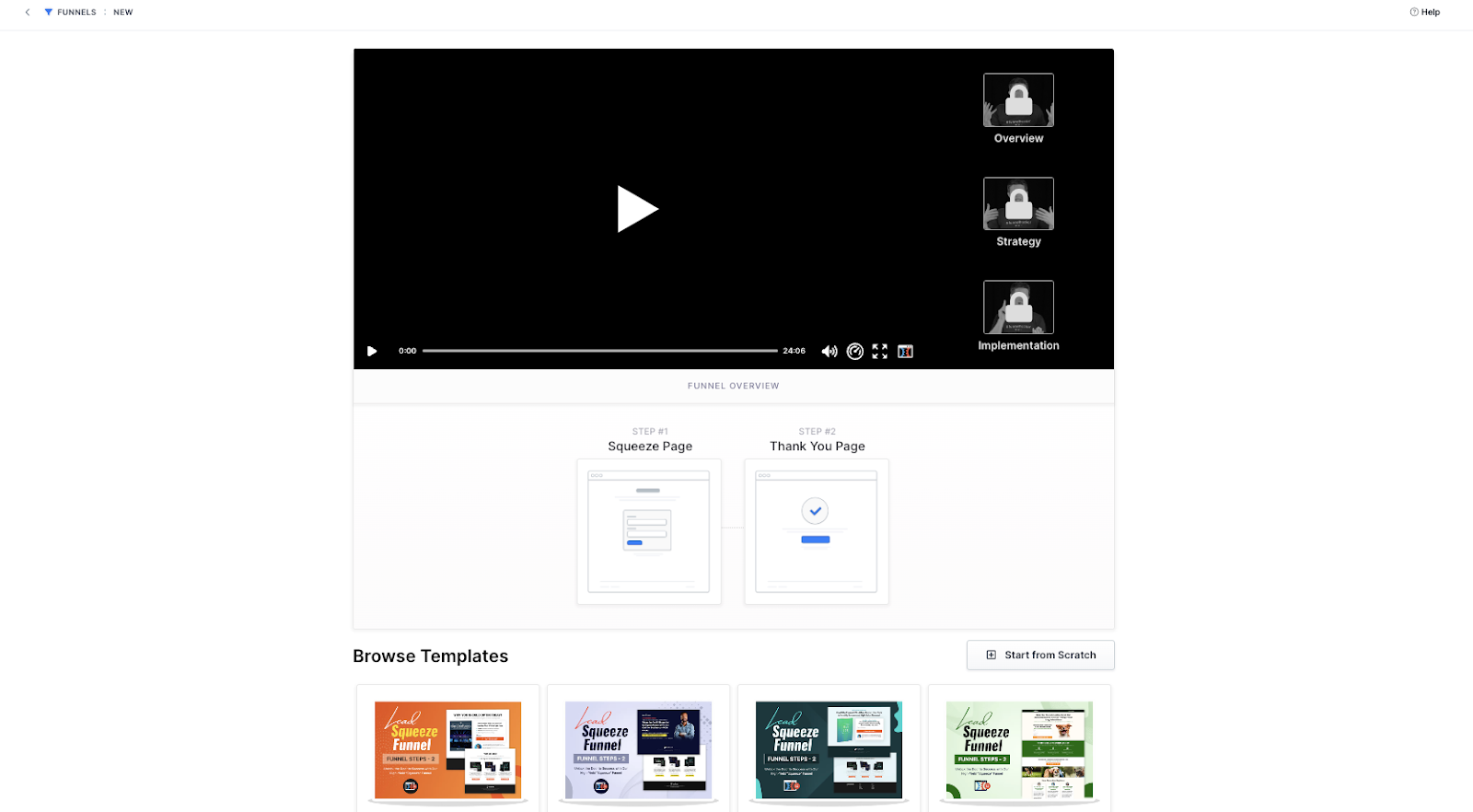
Within just a few seconds, I had the funnel right in front of me. And, I mean, you can already see the difference in how much more in-depth this is compared to Kajabi.
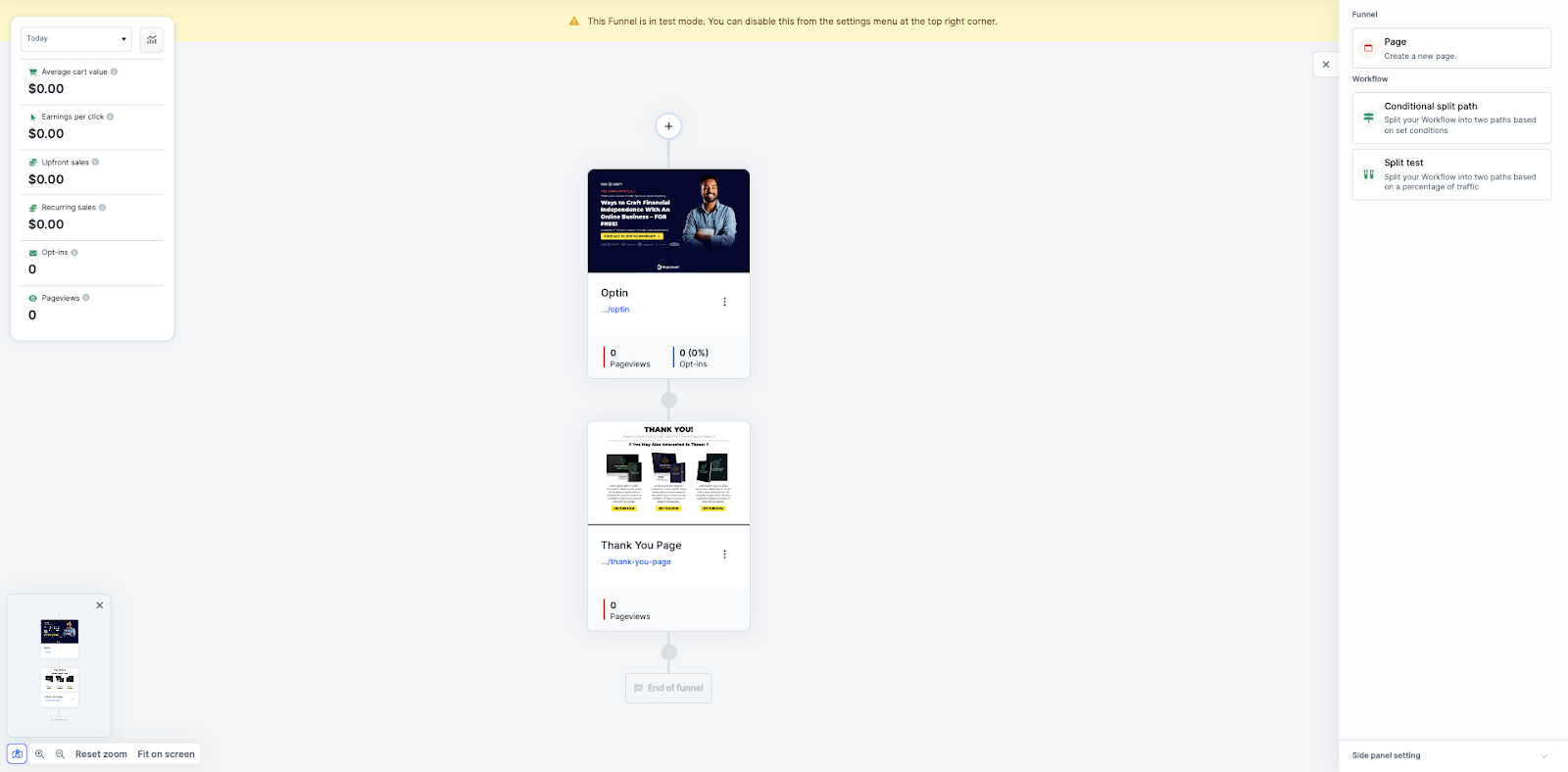
To get into more detail, I can add as many steps as I want within this, each of which is fully customizable. It can be a page, a split test, or a conditional split test, with all the data I need being right on there.
Now, I’m not the best at creating funnels. Far from it. But ClickFunnels made it pretty easy to make something basic but effective enough for, say, selling my courses or coaching classes.
The point here definitely goes to ClickFunnels. So, Kajabi vs ClickFunnels: 2-2.
It’ll all come down to pricing. Which of the two is the best value?
Pricing: Is Kajabi or ClickFunnels better value?
Right off the bat, the 2 platforms have some pretty significant differences in their pricing plans. Kajabi offers 4 compared to ClickFunnels’ 2 plans. So, Kajabi is already a little bit ahead. Let’s get onto the actual prices and what each one offers, though.

Kajabi’s 4 pricing plans are as follows (all plans come at a discount if you pay annually):
- Kickstarter for $69/month
- Basic for $149/month
- Growth for $199/month
- Pro for $399/month
Kickstarter is only available to new users and comes with the fewest number of features. For one, you can only publish 1 product and have 1 funnel, and the number of landing pages you can have and marketing emails you can send is limited.
As I checked out the other plans, I found a clear one that had the best value and, uncoincidentally, the most popular: Growth. For just an extra $50/month, you get tons more products and funnels, can cater to more active customers, and have plenty of great add-ons, like advanced automations.
As for the other 2 plans, Basic and Pro, I’d say that the former isn’t the best value, while the latter is definitely for larger businesses with nearly 20k active customers.
Now, I was ready to declare Kajabi the winner, but ClickFunnels’ pricing actually surprised me.
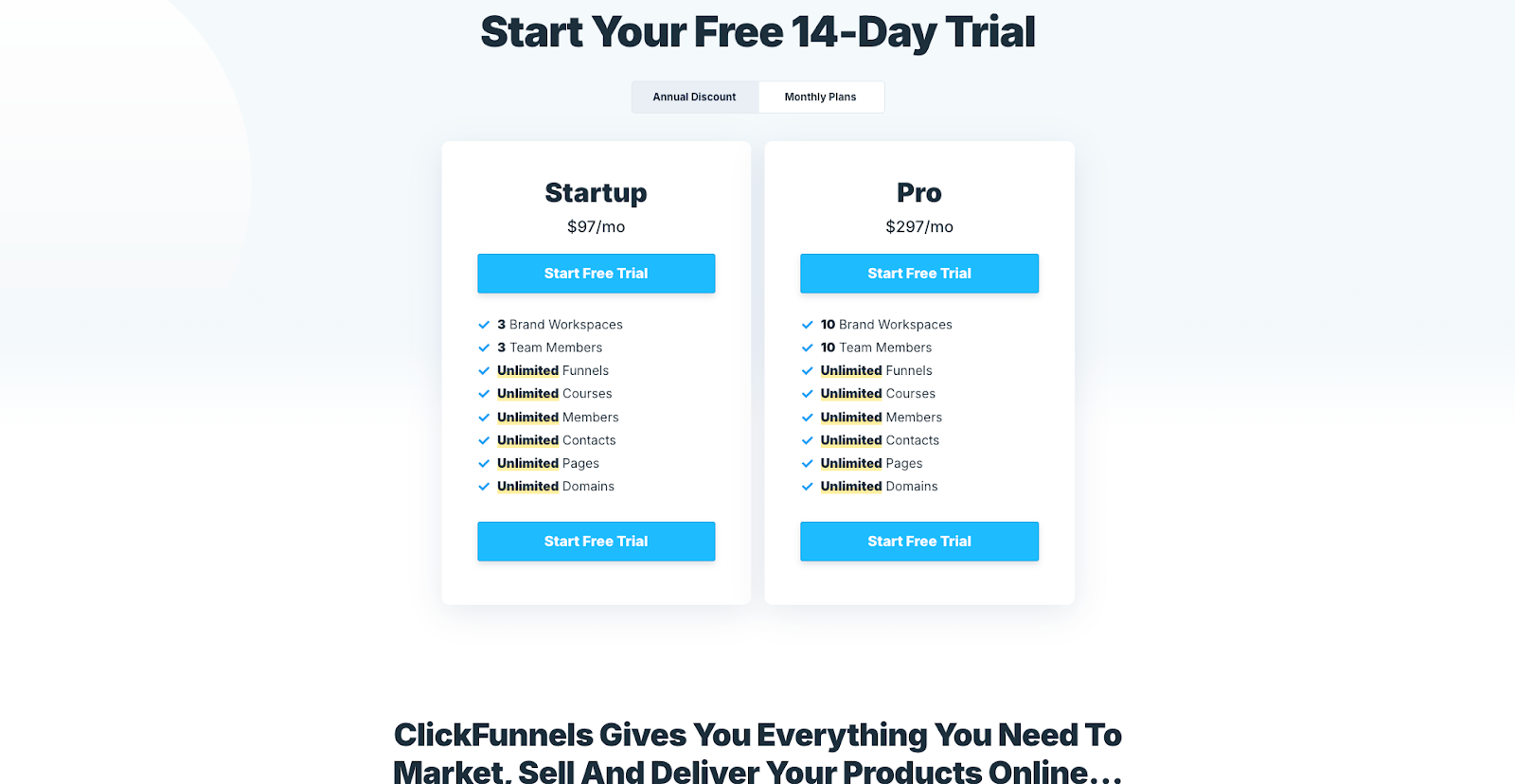
The 2 ClickFunnels pricing plans are Startup for $97/month and Pro for $297/month, with discounts for annual payments. And, here’s where things got interesting.
Both plans only limit your workspaces and team members. This means that you can host unlimited courses, create unlimited funnels, and cater to unlimited customers. Startup limits workspaces and members at 3, while Pro takes that up to 10.
And, this brings me to the final question: Which one is better value?
I have to say that both Kajabi and ClickFunnels offer great value for their price. From what I saw while reviewing these 2 platforms, though, I believe ClickFunnels is the best value out of the 2. You just can’t beat the fact that they don’t put a limit on any of their features.
Now, does this mean we have a winner? Not just yet. Let’s check out my verdict on Kajabi and ClickFunnels.
The Verdict
So, which of the two platforms is better I hear you ask. Let’s take it from the beginning.
The onboarding was straightforward on both platforms. They both have a great UI, and they’re pretty easy to navigate. ClickFunnels is a little bit more complex to go through, so Kajabi is slightly ahead on that part.
My verdict would be this:
- Out of the two, Kajabi is best optimized for digital products. They’ve got everything you’d expect and besides some limitations, I think that it’s one of the best platforms to sell courses, coaching, and access to communities.
- ClickFunnels is the best for everything else, though. They’re still a great choice for digital products, like courses and communities, but it’s clearly more targeted to physical products.
If I had to choose one of the two, I’d go for ClickFunnels if I was selling anything physical and Kajabi for anything digital. That is if I only had these 2 options to choose from.
When it comes to digital products for digital products, there’s one platform that I consider better than Kajabi and ClickFunnels. That platform is Whop.
Why Whop excels over Kajabi and ClickFunnels

Whop, like Kajabi, is an all-in-one platform for everything digital. When you sign up on Whop, you create a whop that gives you access to tons of different apps similar to those that ClickFunnels has. There, like CF, you can host your courses and communities. But you can do so much more within your whop.
Do you want to host live coaching classes or private calls with community/course members? There’s a video call app that allows you to do just that. What about webinars and masterminds? You can host these here as well, through the Events app. Files and downloadable assets? There’s a Files app on your whop for just that.
When it comes to building your website, Whop allows you to create a custom storefront that will be hosted within the platform. As for payments, you won’t need any integrations, as you can get paid through Whop Payments, which also acts as your Merchant of Record, something neither Kajabi nor ClickFunnels does.
And what about marketing and sales tools? When you create your whop, you’ll find all the analytics you need straight on your dashboard. There, you’ll also find marketing tools, like tracking links, and be able to use promo codes.
I know what you’re thinking: “This must cost much more than Kajabi and ClickFunnels, right?” Well, creating a whop doesn’t cost you anything. If you’re just starting out, you can essentially use all the apps I mentioned above for free. And, when you do make a sale, you'll be able to keep up to 97% of it.
On top of all of this, Whop also allows you to go down a different route with your online business. If you don't want to actively sell your digital products, you can become an affiliate with any and every whop out there.
Through Whop Affiliates, you'll be able to easily get affiliated with specific whops or entire categories. And the process is super simple. You just have to copy your affiliate link for a whop or category and share it with your followers.
When they make a purchase through your links, you get a cut, ranging from 20%-50% of what Whop makes.
Start your online business with Whop today

Look, there's no doubt that Kajabi and ClickFunnels are incredible platforms, and they're definitely great places to start your online business. But why go with great when you can go with the best? In this case, Whop is hands down the best.
It's free to start, gives you access to tons of different apps, and allows you to make money not only through selling your digital products but also by becoming an affiliate for other whops.
The choice is now up to you. If you want to start your business with the best platform, sign up to Whop. Create your whop within the next few minutes and monetize your courses, communities, ebooks, podcasts, newsletters, and everything in between.


